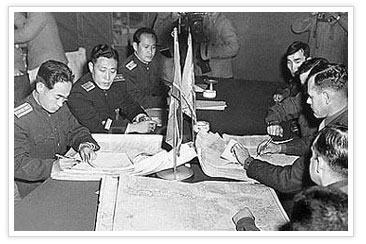 |
Background of the Agreement |
|
Korean Forces that had withdrawn to the Nakdong River due to illegal invasion from the DPRK Forces succeeded to recapture Seoul through U.N Force’s Inchon Landing Operation, and then continued to head north till the capture of Pyongyang on 20 October 1950; however, right before a full unification, the situation reversed with intervention from the Chinese Forces on 19 Nov 1950 forcing the U.N Forces to withdrew to Osan. As the U.N Forces started its counterattack operation on 15 Jan 1951, it recaptured Seoul on 4 Mar 1951 and advanced to the 38th Parallel on 24 Mar 1951.
|
On 12 Mar 1951, General Ridgeway, Commander of the 8th U.S. Army, said, “It would be a huge victory to the U.N forces if the armistice would occur at the 38th Parallel”. Also the U.S Government started to discuss an armistice instead of attacking pass the 38th Parallel.
On 16 Jun 1951, UN Secretary General Trigbri officially proposed armistice for the Korean War; 27 June, Gromyko, Chief of Foreign Affairs of the Soviet Union, announced declaration concerning the armistice. The U.S. Government announced declaration after investigation on the Soviet Union’s proposal; 29 Jun 1951, the U.S Government ordered Gen. Ridgeway, Commander of U.N forces, to propose the armistice.
Through broadcasting, Commander Ridgeway with authorization from the U.S. Government, proposed to the communist to have a liaison officer’s contact for the armistice at a Denmark hospital ship at the WonSan port.
|
|
|
| Location
of signing |
Gen Kim, Nam-il, Representative of the Armistice Conference |
Signing of the Armistice Agreement |
After 2~3 proposals and counter proposals through broadcasting, the first contact was made after both sides agreed to have a preliminary conference at ‘Laebongjang’, north of Gaesung, on 8 July 1951 with Colonel-level representation from both sides. As they agreed on the preliminary conference, 10 July 1951, they held their first Armistice Conference; afterwards 26 conferences in Gaesung (Laebongjang). On 20 July 1951, they moved the location of the Conference to Panmunjom, and continued the Armistice Conference. During those days, they had 765 conferences including 159 main conferences, 179 sectional committee meetings, 188 staff officer’s meetings, and 238 liaison officer meetings. On 25 July 1953, the Armistice Agreement was finally signed. |




